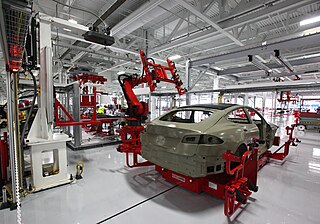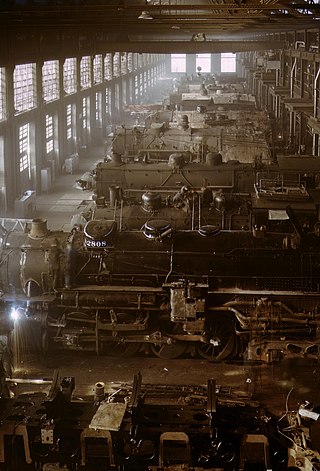
The tertiary sector of the economy, generally known as the service sector, is the third of the three economic sectors in the three-sector model. The others are the primary sector and the secondary sector (manufacturing).

The term "Third World" arose during the Cold War to define countries that remained non-aligned with either NATO or the Warsaw Pact. The United States, Canada and their allies represented the "First World", while the Soviet Union, China, Cuba, North Korea, Vietnam, and their allies represented the "Second World". This terminology provided a way of broadly categorizing the nations of the Earth into three groups based on political divisions. Due to the complex history of evolving meanings and contexts, there is no clear or agreed-upon definition of the Third World. Strictly speaking, "Third World" was a political, rather than economic, grouping.

Manufacturing is the creation or production of goods with the help of equipment, labor, machines, tools, and chemical or biological processing or formulation. It is the essence of the secondary sector of the economy. The term may refer to a range of human activity, from handicraft to high-tech, but it is most commonly applied to industrial design, in which raw materials from the primary sector are transformed into finished goods on a large scale. Such goods may be sold to other manufacturers for the production of other more complex products, or distributed via the tertiary industry to end users and consumers.

Import substitution industrialization (ISI) is a trade and economic policy that advocates replacing foreign imports with domestic production. It is based on the premise that a country should attempt to reduce its foreign dependency through the local production of industrialized products. The term primarily refers to 20th-century development economics policies, but it has been advocated since the 18th century by economists such as Friedrich List and Alexander Hamilton.
Development economics is a branch of economics that deals with economic aspects of the development process in low- and middle- income countries. Its focus is not only on methods of promoting economic development, economic growth and structural change but also on improving the potential for the mass of the population, for example, through health, education and workplace conditions, whether through public or private channels.

In sociology, an industrial society is a society driven by the use of technology and machinery to enable mass production, supporting a large population with a high capacity for division of labour. Such a structure developed in the Western world in the period of time following the Industrial Revolution, and replaced the agrarian societies of the pre-modern, pre-industrial age. Industrial societies are generally mass societies, and may be succeeded by an information society. They are often contrasted with traditional societies.
In the mid-1980s, Communist Czechoslovakia was prosperous by the standards of the Eastern Bloc, and did well in comparison to many richer western countries. Consumption of some goods like meat, eggs and bread products was even higher than the average countries in Western Europe, and the population enjoyed high macroeconomic stability and low social friction. Inhabitants of Czechoslovakia enjoyed a standard of living generally higher than that found in most other East European countries. Heavily dependent on foreign trade, the country nevertheless had one of the Eastern Bloc's smallest international debts to non-socialist countries.

In sociology, the post-industrial society is the stage of society's development when the service sector generates more wealth than the manufacturing sector of the economy.
Backwardness is a lack of progress by a person or group to some perceived cultural norm of advancement, such as for example traditional societies relative to modern scientific and technologically advanced industrialized societies.

Underdevelopment, in the context of international development, reflects a broad condition or phenomena defined and critiqued by theorists in fields such as economics, development studies, and postcolonial studies. Used primarily to distinguish states along benchmarks concerning human development—such as macro-economic growth, health, education, and standards of living—an "underdeveloped" state is framed as the antithesis of a "developed", modern, or industrialized state. Popularized, dominant images of underdeveloped states include those that have less stable economies, less democratic political regimes, greater poverty, malnutrition, and poorer public health and education systems.
Modernization theory holds that as societies become more economically modernized, wealthier and more educated, their political institutions become increasingly liberal democratic. The "classical" theories of modernization of the 1950s and 1960s, most influentially articulated by Seymour Lipset, drew on sociological analyses of Karl Marx, Emile Durkheim, Max Weber, and Talcott Parsons. Modernization theory was a dominant paradigm in the social sciences in the 1950s and 1960s, and saw a resurgence after 1991, when Francis Fukuyama wrote about the end of the Cold War as confirmation on modernization theory.
In Marxian economics, economic reproduction refers to recurrent processes. Michel Aglietta views economic reproduction as the process whereby the initial conditions necessary for economic activity to occur are constantly re-created. Marx viewed reproduction as the process by which society re-created itself, both materially and socially.

Development theory is a collection of theories about how desirable change in society is best achieved. Such theories draw on a variety of social science disciplines and approaches. In this article, multiple theories are discussed, as are recent developments with regard to these theories. Depending on which theory that is being looked at, there are different explanations to the process of development and their inequalities.
Stages of development may refer to:

The three-sector model in economics divides economies into three sectors of activity: extraction of raw materials (primary), manufacturing (secondary), and service industries which exist to facilitate the transport, distribution and sale of goods produced in the secondary sector (tertiary). The model was developed by Allan Fisher, Colin Clark, and Jean Fourastié in the first half of the 20th century, and is a representation of an industrial economy. It has been criticised as inappropriate as a representation of the economy in the 21st century.
The Orthodox Development view equates economic growth with 'development'. The gross national product of a country has continually been used by intergovernmental organisations such as the UN, to equate their economical stance to their level of 'development'. This approach to human progress has been critiqued consistently throughout its history, especially by economists such as Dambisa Moyo, with the main criticisms being that the approach is ethnocentric and one-dimensional.
The Mumbai Consensus is a term used to refer to India's particular model of economic development, with a "people-centric" approach for managing its economy which may be taken up by other developing nations in time. Indian model of economic growth, which relies on its domestic market more than exports, boosted domestic consumption rather than investment, pursued service-oriented industries rather than low-skilled manufacturing industries, and has greatly differed from the typical Asian strategy of exporting labor-intensive, low-priced manufactured goods to the West. This model of economic development remains distinct from the Beijing Consensus with an export-led growth economy, and the Washington Consensus focused instead on encouraging the spread of democracy and free trade.
The balanced growth theory is an economic theory pioneered by the economist Ragnar Nurkse (1907–1959). The theory hypothesises that the government of any underdeveloped country needs to make large investments in a number of industries simultaneously. This will enlarge the market size, increase productivity, and provide an incentive for the private sector to invest.
Unbalanced growth is a natural path of economic development. Situations that countries are in at any one point in time reflect their previous investment decisions and development. Accordingly, at any point in time desirable investment programs that are not balanced investment packages may still advance welfare. Unbalanced investment can complement or correct existing imbalances. Once such an investment is made, a new imbalance is likely to appear, requiring further compensating investments. Therefore, growth need not take place in a balanced way. Supporters of the unbalanced growth doctrine include Albert O. Hirschman, Hans Singer, Paul Streeten, Marcus Fleming, Prof. Rostov and J. Sheehan.
The anthropology of development is a term applied to a body of anthropological work which views development from a critical perspective. The kind of issues addressed, and implications for the approach typically adopted can be gleaned from a list questions posed by Gow (1996). These questions involve anthropologists asking why, if a key development goal is to alleviate poverty, is poverty increasing? Why is there such a gap between plans and outcomes? Why are those working in development so willing to disregard history and the lessons it might offer? Why is development so externally driven rather than having an internal basis? In short, why is there such a lack of planned development?








